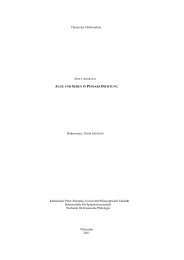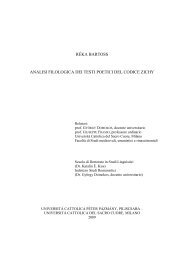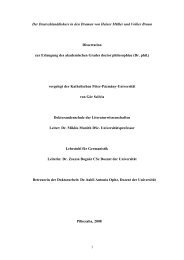PÉTER ILLIK TURKISH RAIDS IN TRANSDANUBIA PhD ... - Index of
PÉTER ILLIK TURKISH RAIDS IN TRANSDANUBIA PhD ... - Index of
PÉTER ILLIK TURKISH RAIDS IN TRANSDANUBIA PhD ... - Index of
You also want an ePaper? Increase the reach of your titles
YUMPU automatically turns print PDFs into web optimized ePapers that Google loves.
<strong>PÉTER</strong> <strong>ILLIK</strong><br />
<strong>TURKISH</strong> <strong>RAIDS</strong> <strong>IN</strong> <strong>TRANSDANUBIA</strong><br />
<strong>TURKISH</strong> PLUNDER<strong>IN</strong>G ON THE FR<strong>IN</strong>GES OF THE <strong>TURKISH</strong> SUBJECTION<br />
<strong>IN</strong> THE <strong>TRANSDANUBIA</strong>N TERRITORY <strong>IN</strong> THE FIRST HALF OF THE 17 TH CENTURY<br />
<strong>PhD</strong> thesis<br />
Consultant teacher: J. Újváry Zsuzsanna,<br />
associate pr<strong>of</strong>essor, PPKE BTK<br />
PPKE BTK<br />
Piliscsaba<br />
2009
Acknowledgements<br />
Sincere thanks to the consultant teacher <strong>of</strong> the research, Mrs. J. Újváry Zsuzsanna (<strong>PhD</strong>).<br />
Special thanks to the reviewers <strong>of</strong> the <strong>PhD</strong> dissertation, Doctors <strong>of</strong> Humanities Vera Zimányi,<br />
Klára Hegyi, Pál Fodor and Balázs Sudár (<strong>PhD</strong>).<br />
2
1. Research plan and the written primary sources<br />
The research is based on two Hungarian historical terms and phenomenon. It explores<br />
the features <strong>of</strong> the “peaceful wartimes” in Western Transdanubia in the first half <strong>of</strong> the 17 th<br />
century. From the Turkish-Hungarian Peace Treaty <strong>of</strong> Zsitvatorok (1606) there was a peaceful<br />
period for Royal Hungary confirmed by several peace treaties after 1606. However, the<br />
Turkish armies continuously ravaged the fringes <strong>of</strong> the Subjection during the peace. They<br />
plundered those parts <strong>of</strong> the Hungarian Kingdom, which were behind the defence line <strong>of</strong><br />
Hungarian fortresses. Even though they were integral parts <strong>of</strong> Royal Hungary but defenceless<br />
against the Turkish troops who could go through the gaps <strong>of</strong> the Hungarian defences.<br />
This <strong>PhD</strong> essay analyzes the damages done by the Turkish army based on Hungarian<br />
sources and records in a Hungarian point <strong>of</strong> view. Its major aim is to summarise a massive<br />
amount <strong>of</strong> data consisting <strong>of</strong> every published and unpublished sources concerning the given<br />
topic. In this way, an objective evaluation <strong>of</strong> losses can be achieved without subjective<br />
exaggerations. In addition, the historical hiatus mentioned by Ferenc Szakály can be filled.<br />
(„A hódoltsági peremvidék története, amely – s ezt nem árt még egyszer hangsúlyozni – a<br />
hódoltságétól merőben eltérő problematika, külön monográfiát igényelne, amelyhez a magyar<br />
történetírás már eddig is számtalan részletfeldolgozással és forráskiadvánnyal készült fel.”<br />
Citation from Ferenc Szakály)<br />
The records regarding Turkish activities <strong>of</strong> the Batthyány family gave the core <strong>of</strong> the<br />
research added up by conscriptions <strong>of</strong> the counties, lexicons, archives <strong>of</strong> the palatine and the<br />
Urbaria et Conscriptiones.<br />
3
The most important sources:<br />
Batthyány-család levéltára (Archive <strong>of</strong> the Batthyány family):<br />
MOL Batthyány-cs. levéltára, Török vonatkozású iratok P 1313/248–249. cs.<br />
MOL Batthyány-cs. levéltára, Missiles P 1314<br />
MOL Batthyány-cs. levéltára, Batthyány Ádám leveleskönyve P 1315/I–IV. kötet<br />
MOL Batthyány-cs. levéltára, Instrukciók P 1322/37 cs.<br />
MOL Batthyány-cs. levéltára, Tiszttartókkal való levelezés P 1322/26 cs.<br />
MOL Batthyány-cs. levéltára, Urbáriumok P 1322/79 cs. (Filmtár, 4315. doboz, Németújvár)<br />
MOL Batthyány-cs. levéltára, Urbáriumok P 1322/ No 36, 37, 38, 41, 52 (Filmtár, 4331–<br />
4332. doboz, Körmend, Dobra, Muraszombat, Rakicsán)<br />
Magyar Kamara Archivuma (Archive <strong>of</strong> the Hungarian Chamber):<br />
MOL Archivum Familiae Thurzó E 196/4. cs.<br />
MOL Archivum Familiae Wesselényi E 199/6 cs.<br />
MOL Urbaria et Conscriptiones (UC) E 156/1/16., 6/56., 9/62., 10/37., 10/77a.,10/78., 11/9.,<br />
14/35., 23/5., 23/14., 45/28., 110/4., 113/16 b., 116/4.<br />
MOL Conscriptiones portarum E 158/9.cs. Jauriensis, 1531–1635. (Filmtár, 1636. doboz)<br />
MOL Conscriptiones portarum E 158/12. cs. Castri Ferrei, 1598–1648. (Filmtár, 1632–1633.<br />
doboz)<br />
MOL Conscriptiones portarum E 158/50. cs. Veszpremiensis, 1569–1696. (Filmtár, 1659.<br />
doboz)<br />
MOL Conscriptiones portarum E 158/54. cs. Szaladiensis, 1609–1696. (Filmtár, 1664. doboz)<br />
Az Esterházy család Hercegi ágának levéltára (Archive <strong>of</strong> the Prince's branch <strong>of</strong> the<br />
Esterházy family):<br />
MOL Repositorium 71. Esterházy Miklós Nádor iratai P 108/479/26/a (Filmtár, 6564–6565.<br />
doboz)<br />
MOL Repositorium 72. Esterházy Pál közügyekre vonatkozó iratai P 108/482/32 (Filmtár,<br />
16199. doboz)<br />
MOL Esterházy Miklós nádor iratai, P 123/6 cs. (Filmtár, 4686–4687. doboz)<br />
Printed sources:<br />
Fekete, Ludwig: Türkische Schriften aus dem Archive des Palatins Nikolaus Esterházy. Bp.,<br />
1932.<br />
Ila Bálint-Kovacsics József: Veszprém megye helytörténeti lexikona. Bp., Akadémiai, 1964.<br />
Kazinczy Gábor: Adalékok a török-magyar kori beltörténethez. Hivatalos nyomozások a török<br />
adó és hódítások körül Borsodban a XVII. század I. felében. Történelmi Tár 1858. 101–167.<br />
Komáromy András: A kanizsai török rablásai 1630–1640. Hadtörténelmi Közlemények 1895.<br />
8. szám. 79–92.<br />
Kovacsics József. Zala megye helytörténeti lexikona. Keszthely és környéke. Bp., 1991.<br />
Magyar Gazdaságtörténelmi Szemle (MGtSZ) 1894–1906. OSZK Mikr<strong>of</strong>ilmtár FM 3/3800.<br />
1–3 doboz.<br />
4
Magyar történeti szöveggyűjtemény II/1 1526–1790. Szerk. Sinkovics István. Bp.,<br />
Tankönyvkiadó, 1968.<br />
Majláth Béla: Az 1642-ik évi szőnyi békekötés története. A szőnyi béke okmánytára. Bp.,<br />
Akadémiai, 1885.<br />
Matunák Mihály: Az 1599. évi barsvármegyei tatárjárás. Történelmi Tár 1905. 590–599.<br />
Matuz, Josef: Die Steuerkonskriotion des Sandschaks Stuhlveissenburg aus den Jahren 1563<br />
bis 1565. Bamberg, 1986.<br />
Merényi Lajos: A kanizsai végek történetéhez. Hadtörténelmi Közlemények 1897/II. 259–<br />
265.<br />
Merényi Lajos: A török végek történetéhez. Hadtörténelmi Közlemények 1896. 520–523.<br />
Merényi Lajos: A zalai hódoltság történetéhez. Hadtörténelmi Közlemények 1911. 368–372.<br />
Merényi Lajos: Bars, Hont és Nógrád 1630-iki sérelmei a török végbeliektől. Hadtörténelmi<br />
Közlemények 1897/III. 448–451.<br />
Merényi Lajos: Heves vármegye panaszai a török ellen. 1629. Hadtörténelmi Közlemények<br />
1897/II. 302–305.<br />
Merényi Lajos: Nádori óvás a török békeszegései ellen. Történelmi Tár 1889. 565–573.<br />
Merényi Lajos: Adatok a hódoltság adózása történetéhez. Magyar Gazdaságtörténelmi Szemle<br />
1903. 18–32.<br />
Pákay Zsolt: Veszprém vármegye története a török hódoltság korában a rovásadó összeírások<br />
alapján (1531–1696). Veszprém, 1942.<br />
Ráth Károly: A Győr vármegyei hódoltságból. Magyar Történelmi Tár 1860. 1–91.<br />
Ráth Károly: Győr vármegyének 1642. évben összeírt sérelmi jegyzőkönyve a török ellen.<br />
Magyar Történelmi Tár 1860. 92–123.<br />
Salamon Ferencz: Magyarország a török hódoltság korában. Bp., 1886.<br />
Salamon Ferencz: Két magyar diplomata a tizenhetedik századból. Pest, 1867.<br />
Stahl Ferenc: Vas megyei török hódoltság összeírása a XVII. század közepéről. Vasi Szemle<br />
1970. 114–123, 298–308.<br />
Szerémi [Odescalchi Arthur]: Emlékek Barsvármegye hajdanából. Bp., Athaeneum, Megj.<br />
Mint korábban) 1892.<br />
Urbáriumok XVI–XVII. század. Szerk. Maksay Ferenc, Bp., Akadémiai, 1959.<br />
Varga Endre: Úriszék, XVI–XVII. századi perszövegek. Bp., 1958.<br />
Velics Antal: Török levelek a kismartoni levéltárból. Történelmi Tár 1885. 575–587.<br />
5
2. Methods <strong>of</strong> the analysis<br />
The sources were analysed and sorted in a hierarchical order. The unfolded items <strong>of</strong><br />
data (numbers <strong>of</strong> killed, kidnapped people, etc.) were put into historical context and in the<br />
political situation <strong>of</strong> Hungary. I attempted to describe the features <strong>of</strong> the living conditions on<br />
the fringes instead <strong>of</strong> explaining the causes behind events. Because the causes behind the<br />
events cannot be explained based on these records, therefore, this dissertation is mostly<br />
descriptive<br />
This synthesis raised several methodical problems. The most important one was the<br />
large number <strong>of</strong> different names <strong>of</strong> locations in different standards. The proper transcription<br />
and identification <strong>of</strong> names was very relevant but it was not the main objective <strong>of</strong> the<br />
dissertation. Therefore, I identified the villages as much as I could based on wide spread<br />
historical handbooks. In addition, I registered the names <strong>of</strong> villages <strong>of</strong> counties Győr, Vas,<br />
Veszprém and Zala in the Appendix. (Based on Ferenc Maksay: Magyarország<br />
birtokviszonyai a 16. század közepén I–II. Bp., Akadémiai, 1990.) In the <strong>Index</strong>, the names are<br />
in modern form.<br />
Nationwi<br />
de<br />
Countywide damages<br />
Losses <strong>of</strong> the Batthyány estates and fortresses<br />
Sources: nationwide<br />
records.<br />
Sources: countywide<br />
records, lexikons, Urbaria<br />
et Conscriptiones.<br />
Sources: records <strong>of</strong> the<br />
Batthyány archive.<br />
The records were analyzed mostly in statistic way. Therefore, beside the narrative<br />
analysis there are line and pie charts and tables. In addition, the expansion <strong>of</strong> the Turkish<br />
6
Subjection and the regions <strong>of</strong> captured villages are illustrated on maps. The most important<br />
statistic tools are the followings:<br />
1. Line charts: 25 line charts represent the changes <strong>of</strong> different processes, like the Turkish<br />
expansion on the fringes <strong>of</strong> the Subjection. These charts illustrate how many villages were<br />
plundered and forced to pay tax to the Turks. During this process, Hungarian villages were<br />
forced into submission and terrorised. Therefore, they had to accept the Turkish authority over<br />
them and had to pay tax to their spahis. The swelling numbers <strong>of</strong> captured villages extended<br />
the borders <strong>of</strong> the fringes <strong>of</strong> the Subjection and the occupation <strong>of</strong> Hungarian fortresses<br />
expanded the Subjection itself.<br />
These charts also analyse the increasing rate <strong>of</strong> the sums (=summa) <strong>of</strong> taxes. These<br />
taxes also devastated the conquered villages because they put heavy financial pressure on the<br />
inhabitants.<br />
Number <strong>of</strong><br />
subjugated villages<br />
Number <strong>of</strong> subjugated<br />
villages<br />
Subjugated Hungarian villages in county Győr<br />
until 1619<br />
25<br />
20<br />
15<br />
10<br />
40<br />
30<br />
20<br />
10<br />
5<br />
0<br />
0<br />
4<br />
1592<br />
1595<br />
7<br />
10 12 14 16 19 20 22 23<br />
1606<br />
1608<br />
1609<br />
1610<br />
1611<br />
Year<br />
Subjugated villages in county Vas between 1543-1649<br />
1543<br />
1589-90<br />
1600<br />
1605<br />
1620<br />
Year<br />
1640<br />
1642<br />
1612<br />
1614<br />
1617<br />
1619<br />
1644<br />
1646<br />
33<br />
7
Tax in forint<br />
160<br />
140<br />
120<br />
100<br />
80<br />
60<br />
40<br />
20<br />
0<br />
Changes <strong>of</strong> the tax peid to the spahi in county Bars betwwe 1613-<br />
1615<br />
90<br />
40 35 30 32<br />
150<br />
130<br />
135<br />
127<br />
100<br />
84<br />
75<br />
57<br />
85<br />
65<br />
1613 1614 1615<br />
Year<br />
Besenyő<br />
Hul<br />
Ohay<br />
Nagymánya<br />
Valkaz<br />
2. Pie charts: these charts represent ratios <strong>of</strong> sex or age range <strong>of</strong> captured villagers (male-<br />
female, adult-child) or ratio <strong>of</strong> the status <strong>of</strong> villages (captured-not captured).<br />
Subjugated villages in county Győr<br />
Not<br />
subjugated or<br />
not in county<br />
Győr; 40%<br />
Subjugated;<br />
60%<br />
3. Tables: I used 54 tables to represent the damages done by the Turks. I constructed and<br />
organised to be clearly understandable and describe the major processes even without<br />
explanation. These tables show the losses <strong>of</strong> people, animals and financial losses <strong>of</strong> the<br />
countryside. Other tables describe the losses <strong>of</strong> the fortresses based on the same methods.<br />
4. Maps: I used six maps on the counties and one group <strong>of</strong> military maps illustrating the<br />
borders <strong>of</strong> the Turkish Subjection.<br />
The maps <strong>of</strong> “Magyarország birtokviszonyai a 16. század közepén.” (Szerk.:<br />
FerencMaksay. Bp., Akadémiai, 1990.) were redrawn and modernised.<br />
8
Border <strong>of</strong> the<br />
rivers Rába-<br />
Marcal<br />
Subjugated villages<br />
Győr megye területe (Territory <strong>of</strong> Győr)<br />
I had to consider the fact that the fringes <strong>of</strong> the Subjection did not have static borders<br />
because it changed dynamically. However, there were geographical restrictions. For example<br />
in county Győr the border was along the rivers Rába-Marcal.<br />
Free villages<br />
9
The maps illustrating the Hungarian fortresses were drawn based on Ferenc Szakály:<br />
Magyar adóztatás a török hódoltságban. Bp., Akadémiai, 1981.<br />
10
There are periods like black holes about which there are not records. Just like the<br />
1610’s and the period between 1660-1670’s. Therefore, the analogous pieces <strong>of</strong> information<br />
from Northern Hungary (county Bars) can be considered.<br />
Beside objective and statistic methods, I also analysed the life conditions on the micro<br />
levels <strong>of</strong> the villages. In this way, the effects <strong>of</strong> the Turkish military actions could be<br />
presented emphasising the fact that behind the cold logic <strong>of</strong> numbers there were personal lives<br />
and tragedies as well.<br />
11
3. Results<br />
The fringes <strong>of</strong> the Turkish Subjection shadowed the territory <strong>of</strong> the Hungarian<br />
Kingdom. It covered the major parts <strong>of</strong> Győr, Vas, Zala and the whole area <strong>of</strong> Veszprém.<br />
However, the exact extension <strong>of</strong> the fringes is not known because the Turks could capture the<br />
villages behind the Hungarian fortresses only temporarily. This means that they forced the<br />
countryside into submission and the Turks “visited” them irregularly to make peasants<br />
remember their bonds.<br />
The Turkish spahis constantly conquered the Hungarian countryside, the conquest<br />
never ceased but there were more intensive periods. Sometimes they had to reconquer, re-<br />
subjugate those villages, which tried to break away. The conquest and capturing villages had<br />
certain methods: kidnapping women and children, burning houses or looting villages. They<br />
just rarely killed the peasants because it was not pr<strong>of</strong>itable. Sometimes the villagers could not<br />
bear their burdens so they fled their homes. Based on the sources the emigration <strong>of</strong> peasantry<br />
was serious in the most unfortunate villages.<br />
The synthesis <strong>of</strong> previous researches and the revealed new records resulted in<br />
significant electrifying achievements. For example, the revision the conscription <strong>of</strong> county<br />
Vas, first published Ferenc Stahl based on the original records. The researches <strong>of</strong> Éva Simon<br />
on the Turkish expansion in Csernecség, county Zala were integrated with my collection <strong>of</strong><br />
data proved that the Turkish expansion started in that region in the 1580’s and continued even<br />
in the 1630’s. Regarding the” problem <strong>of</strong> the 60 villages” <strong>of</strong> Bars, published and unpublished<br />
records <strong>of</strong> palatine Miklós Esterházy (1625-1645) were integrated with newly found items <strong>of</strong><br />
palatine György Thurzó (1609-1616). It also underlined that this political scandal <strong>of</strong> the 17 th<br />
century lasted during decades, from the palatineship <strong>of</strong> Thurzó to Esterházy.<br />
Beside the losses <strong>of</strong> villages, there is massive amount <strong>of</strong> data on the Hungarian<br />
fortresses as well. (There are also some fragments about the northern fortresses, which are<br />
under processing.) Compared with the results <strong>of</strong> József Kelenik’s research there was an 8%<br />
mortality rate among the Hungarian soldiers in Western Transdanubia.<br />
This essay described the amount <strong>of</strong> conquered villages, taxation and other losses based<br />
on mostly the records <strong>of</strong> the Batthyány family archives. Nevertheless, the causes behind the<br />
events were not revealed. For example, there were short peaks <strong>of</strong> periods in which the Turkish<br />
military effort was more intensive, than before or after. I do not know for sure that there is a<br />
concrete political explanation or it is only the lack <strong>of</strong> sources. For instance, after the 1660’s<br />
12
lists <strong>of</strong> losses do not exist but it seems impossible that there were not Turkish raids or the rate<br />
<strong>of</strong> losses decreased.<br />
Finally, determined by the characteristics <strong>of</strong> the records and sources, the losses and the<br />
features <strong>of</strong> life conditions on the fringes (caused by the Turkish army in the first half <strong>of</strong> the<br />
17 th century in Western Transdanubia) could be evaluated and described.<br />
13
4. Bibliography<br />
Books:<br />
● Péter Illik: Collected letters <strong>of</strong> scientists in Debrecen to Sámuel Székely Dobai. (Source<br />
material) Piliscsaba, Pázmány Péter Catholic University, 2007.<br />
● Péter Illik: The “post-postmodern” Europe. Budapest, WZ Könyvek 2008.<br />
● Péter Illik: Turkish plundering in Transdanubia (Under publishing, forthcoming in 2009.)<br />
Historical essays, articles:<br />
● Péter Illik: Plunderings in the Batthyány estates during the Bethlen revolt (1619-22). In.:<br />
“Tanulmányok évszázadok történelméből”. Edited: Zsuzsanna Újváry, András Forgó, Péter<br />
Illik. Piliscsaba, Pázmány Péter Catholic University, 2006. pp.113-133.<br />
● Péter Illik: Turkish-Hungarian “war during peaceful periods” in the Batthyány estates<br />
(1630-1650). In.: Khronosz. Szerk.: Zsuzsanna Újváry. Piliscsaba, Pázmány Péter Catholic<br />
University, 2008. pp. 43-56.<br />
● Péter Illik: Functions <strong>of</strong> rural judges in Batthyány estates in the 17th century. In.:<br />
“Agrártörténeti Szemle” (Under publishing, forthcoming in 2009.)<br />
● Péter Illik: Correspondence and writing on history in Hungary in the 18th century. In.:<br />
Summa. Piliscsaba, Pázmány Péter Catholic University, 2007. pp.124-127.<br />
● Péter Illik: Die Aufgaben der Dorfmeister in Batthyánys Gütern im 17. Jahrhundert. In.:<br />
Schlainige Geschpräche, Schlaining [Szalónak], Ausztria. (Under publishing, forthcoming in<br />
2009.)<br />
● Péter Illik: „Kriegerische friedensjahre” auf dem gebiet des Batthyány-landgutes. (1630-<br />
1650) In.: Schlainige Geschpräche, Schlaining [Szalónak], Ausztria. (Under publishing,<br />
forthcoming in 2009.)<br />
● Péter Illik: Turkish expansion in Vas county between 1606-1649. (Under publishing,<br />
forthcoming in 2009.)<br />
● Péter Illik: Miklós palatine and the grievances <strong>of</strong> Hungary. Turkish raids and plundering<br />
reported to Miklós Estrházy. (Under publishing, forthcoming in 2009.)<br />
14
Minor reviews:<br />
● Péter Illik: “Pictureless” cultural history (Review on Tibor Grüll: The history <strong>of</strong> European<br />
culture (“Az európai művelődés története”, coursebook for high-school students.) Budapest,<br />
Mentor, 1999.<br />
● Péter Illik-Balázs Somogyi: New words, new meanings (Review on Gábor Kiss- Ferenc<br />
Pusztai: New words, new meanings “Új szavak, új jelentések” dictionary <strong>of</strong> modern words).<br />
Piliscsaba, 2000. Campus.<br />
15
5. Conference lectures (2003-2006)<br />
● Turkish-Hungarian “war during peaceful periods” in the Batthyány estates between 1630-<br />
1640. In.: Veszprém, 22 April 2003.<br />
● Turkish-Hungarian “war during peaceful periods” in the Batthyány estates between 1630-<br />
1650. In.: Pázmány Péter Catholic University, 10 June 2005.<br />
● „Kriegerische Friedensjahre” auf dem Gebiet des Batthyány-Landgutes (1630–1650) In.:<br />
Austria, Stadtschlainige Geschpräche, Schlaining [Szalónak], 26-28 September 2005.<br />
● Die Aufgaben der Dorfmeister in Batthyánys Gütern im 17. Jahrhundert. In.: Austria,<br />
Stadtschlainige Geschpräche, Schlaining [Szalónak], 24 September 2006.<br />
● Functions <strong>of</strong> rural judges in Batthyány estates in the 17th century. In.: Pázmány Péter<br />
Catholic University, 10 November 2006.<br />
16






